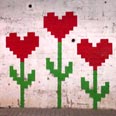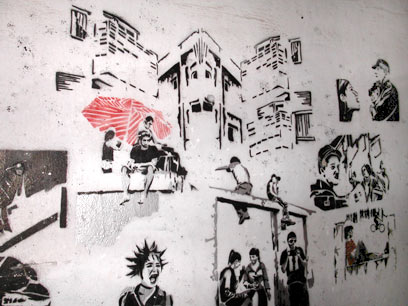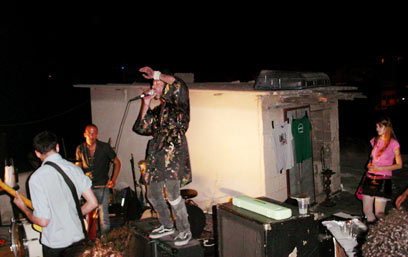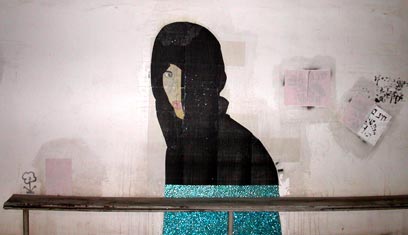

Writers, poets, musicians, and painters gather on the street to satisfy a shared desire for expression and audience, all with the unofficial consent of the city’s authorities. I set out to find the epicenter of the groundswell one Thursday night, trying to find what it is and what fuels it.
I started out in the direction of Florentine, the South Tel Aviv working-class neighborhood. As I walked down Yaffo Road, I came across an empty lot where I found N., a 20-something writer and artist raised in Jerusalem who asked me not to use her name, pasting printed images onto a wall.

Street art in Tel Aviv (Photo: Ashley Rindsberg)
N. wipes glue from her hands as she speaks lucidly about creating art anonymously on the street.
“I look at the street as a public space and I really stand behind the cliché that empty walls equal empty minds,” she says.
She works calmly in the dim light, apparently unfazed by the possibility of being seen.
“Police-wise,” she says when I note that it’s only 10pm, “the awareness has not yet gained full capacity.”
This kind of freedom is a feature of Tel Aviv that much of the youth culture recognizes and is grateful for. Mor Bakal, a 21 year old native of Kfar Vradim, sees the freedom as a product of Israel’s cultural soul-searching.
"Other cultures direct you and your actions,” Mor says, “but here in Tel Aviv there's nothing black and white. Everything's mixed - secular and religious, Jews, Arabs, tourists, art, politics, culture, religion. Nothing is defined."
'Lebanon' on the roof
I continue my journey, drifting towards Jaffa and eventually at the intersection of two streets - Salome and Arthur Schnitzler (named after the Austrian Jewish playwright and author), I see a glow of light emanating from a rooftop and hear the roar of an indie-rock ballad. I find the entrance to the building, which is a semi-industrial squat, and walk upstairs and then climb a steep concrete ramp onto the roof.

Indie-rock on the roof (Photo: Ashley Rindsberg)
This was ‘the scene.’ Or part of it, anyways. A local band called ‘Lebanon’ was playing to a crowd of about fifty people and, though the stage was just gravel, the sound was good and the ‘Arak-agit’ drink, a young tradition of the scene, was flowing.
After the band finished, I sat with Lebanon’s guitarist, Yuval, 23, on the ledge of the roof as he spoke about the scene and street art. “The sound,” he says, “is a lot more difficult outside but lots of times it’s worth it.”
“We’re sort of making use of these spaces which have no other use,” Yuval, who studies architecture and art history, explains. “We're Bringing life to them.”
Soon, another important piece in this evolving puzzle dances up. Mor Elian is a 21 year old Israeli who speaks English with an American accent and seems conversant in both Israeli and American frontier culture
Have you heard of Know Hope?
Part chronicler, part promoter, part artist, and part audience on the scene, she explains that “It's a beautiful kind of art and I want more people to see it. In Israel things can be more conservative, so I want to bring as many people as possible, not to make it mainstream, but to develop that kind of art and music. We just want to get it out there, to show what we have."
And she does exactly this - inviting me to shows, introducing me to her fellow artists, to the organizer of the indie-label Pitkit, and to Tel Aviv’s most prolific, and perhaps enigmatic, street artist, Know Hope.

Art on the walls (Photo: Ashley Rindsberg)
On the phone he’s secretive, calling from a private number and saying “It’s me” instead of his using name, but when we meet later at a café, Know Hope comes across as an experienced, modern-day troubadour wandering on a highly personal artistic mission that, almost by necessity, takes place in a public context.
Having spent part of his childhood in the US, Know Hope sees an advantage in developing as an artist in Tel Aviv. "It's a greenhouse,” he says. “It's a small, tight-knit community. Sometimes you feel like you know everybody and that's when you feel like leaving. But because it's in the beginning stages it’s important."
Know Hope also speaks about ‘the situation’ in Israel and the ‘packaging of tension’ which keep people’s eyes open on the streets of Tel Aviv.
"If you write something on the wall somebody's going to see it so you have to take responsibility,” he says. “Since you're basically forcing it onto people you have to make it aesthetic or appealing or clean or stylized."
The work itself, Know Hope maintains, is political despite the absence of overt political argumentation. “It's ultra-political because I think the politics of communication are actually what makes the waves."
He explains that “Part of it is showing people that we all have hands, we all have something to say. I'm not saying that I want everyone to do street art but just to get things moving.”
From the looks of things on the streets in Tel Aviv, it seems that this kind of movement is not only occurring but growing at a rapid pace. And it will be interesting to see what this newly formed wave will become as it continues to gather speed.















